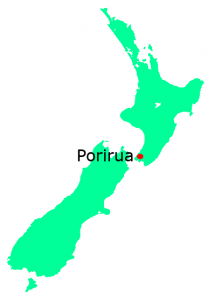About The City
Porirua is a city in the Wellington Region of New Zealand, immediately north of the city of Wellington, with their central business districts 20km apart. A large proportion of the population commutes to Wellington, so it may be considered a satellite city. It almost completely surrounds Porirua Harbour at the southern end of the Kapiti Coast. The eastern (Pauatahanui inlet of the harbour is notable for its world-class estuarine values. The population at the June 2014 estimate was 53,000.

Late afternoon view; Hongoeka Bay and Titahi Bay near top left; Ranui Heights and Kenepuru mid-to-bottom right
History
The name “Porirua” has a Māori origin: it may represent a variant of pari-rua (“two tides”), a reference to the two arms of the Porirua Harbour. In the 19th century the name designated a land-registration district that stretched from Kaiwharawhara (or Kaiwara) on the north-west shore of Wellington Harbour northwards to and around Porirua Harbour. The road climbing the hill from Kaiwharawhara towards Ngaio and Khandallah still bears the name “Old Porirua Road”.
In the 19th century a small European settlement grew up, partly because of the need for a ferry across the harbour. At the time a small Māori settlement already existed.
The Wellington and Manawatu Railway Company opened a railway line to Porirua in 1885, linking the city with Wellington. The railway reached Longburn (south of Palmerston North) in 1886 to connect with the Government’s lines to Taranaki and Napier. With the acquisition of the company by the government in 1908, the line to Porirua formed part of the North Island Main Trunk railway. The railway contributed much to the growth of Plimmerton and Paremata by making day-trips to the beaches from Wellington relatively easy. The line through to Porirua was electrified in 1940 following the construction of the Tawa Flat deviation.
The 1880s and 1890s saw the establishment of the Porirua Lunatic Asylum on the hill south-west of the village. Following the Mental Defectives Act of 1911, the Asylum became Porirua Mental Hospital.
Originally planned in the late 1940s to become a satellite city of Wellington with state housing, Porirua has grown to a city population approaching 54,000, with state housing no longer in the majority. Major territorial additions to the city were made in 1973 and 1988 as part of the reduction and eventual abolition of Hutt County.
Substantial industrial areas generally west of the city centre were established in the 1960s and 1970s, dominated by the Todd Motors building (later Mitsubishi), prominent in the panorama above.
In 1976 the first McDonald’s restaurant in New Zealand opened in the city centre, however the original site closed on 29 April 2009, and the store relocated to Kenepuru Drive.
In 2015 Porirua will celebtate 50 years of being a city.



 CHECK ITS ALRIGHT
CHECK ITS ALRIGHT